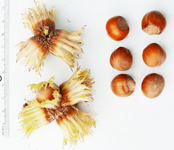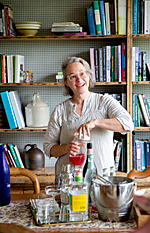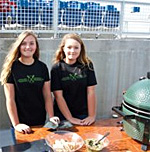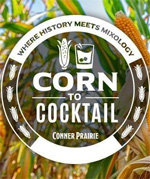Breeding Flavorful Food Crops
 Special to Road Trips for Foodies
Special to Road Trips for Foodies
By American Society of Agronomy and
Crop Science Society of America
Variety is the spice of life – especially when it comes to food. When we think of food crops, we usually think of the basics: wheat, corn, soy, potato and vegetable crops. These staple foods help sustain us for needed calories and nutrition. But, what about the challenges of food crops that add a little extra flavor to our diet? A recent Sustainable, Secure Food blog explores the challenges in breeding hazelnut, hops and mint with guest bloggers from Oregon State University.
Hazelnuts
Most of us don’t eat hazelnuts by the handful – but that could change one day. On their own, hazelnuts are delicious, and their fatty acid profile is identical to olive oil.
According to Shawn Mehlenbacher, Oregon State University’s hazelnut breeding project is “developing new cultivars resistant to eastern filbert blight. This disease is caused by the fungus Anisogramma anomala accidentally introduced from the eastern United States. We are also looking for new cultivars that can resist insect pests, like filbertworm, brown marmorated stink bug, and Pacific flatheaded borer…The Willamette Valley is well-suited to hazelnut production. Acreage devoted to growing hazelnuts Oregon has expanded from 29,000 to 65,000 in the past decade. By creating hybrids between the European and American species, we hope to expand the areas suitable for hazelnut production.”
Hops
Craft brewing fans are also fans of hops – the crop that gives bitterness, flavor and aroma to beer.
“On the fun side of breeding challenges, breeders are working to develop new types of aroma hops – the types that add rich flavors to beers,” says Shaun Townsend. “These types of hops are dominating the market, and breeders are looking for new sources of flavor and aroma. Hop breeders are identifying and incorporating new disease and pest resistant genes into hop, and with aroma hops dominating the market, new sources of flavor and aroma are being sought. Beer is an important beverage for many cultures, and hops will continue to be in demand as one of the key ingredients in beer production.”
Mint
Ah, fresh breath. Many of us can thank the mint oil in our toothpaste for that. “Distilled mint oil is used not only in toothpaste, but in a wide variety of consumer products, candies and medicines,” says Kelly Vining. “The fungal disease Verticillium wilt has been the biggest challenge to mint production in the Pacific Northwest for decades… The wild relatives of cultivated mint may have genes responsible for conferring the wilt resistance trait. Introducing a new cultivar with fungal resistance will help create a more sustainable mint industry.”
Road Trips Foodies can read the full blog online. This blog is sponsored and written by members of the American Society of Agronomy and Crop Science Society of America who are researchers and trained, certified professionals in the areas of growing our world’s food supply, while protecting our environment. They work at universities, government research facilities, and private businesses across the United States and the world.
(Photo of Variety “PollyO” hazelnut developed at Oregon State University by Rebecca McCluskey)


















